For Prime Video’s The Power, Covid hit the Sister team full on, requiring some fancy footwork to finally get it to the screen.
The Power, adapted from Naomi Alderman’s novel, would have always been an epic shoot, spanning North America, South Africa and the UK.

But, with a schedule starting at the very beginning of 2020, the Sister production was faced with the worst the pandemic could offer with cast and team changes, rejigged locations and reshoots added to the mix along the way.
Sister’s involvement with the project goes right back to 2016 as the screen rights for the hit novel were first offered up.
“It arrived in my inbox on a Friday night from Katie Carpenter, who was head of development at the time,” says Jane Featherstone, Sister’s co-founder and exec on the show. “She said, ‘I think you should read it really quickly’” as final offers had to be in that Monday morning. “I knew Naomi’s other work and it was evident that this is something that we should put our hat in the ring for. It’s explosive.” The story has teenage girls, and eventually adult women, acquiring the power to emit electricity from their hands with the new abilities transforming gender power structures across the world.
Featherstone and Carpenter soon met with Alderman, the eleventh indie to do so in the chase for the rights. “But there had been a lot of men in that lineup. Nothing wrong with that,” says Featherstone. “But very few of the meetings had focused on the actual core of the thesis in the book in quite the way that I think we spoke to it.”
With the rights in the bag, the work then started on shaping the adaptation. “It’s multi stranded so there’s an awful lot of structural shaping you have to do,” says Featherstone. “Naomi’s book had a lot of things happening much more quickly, and some things happening much more slowly. So, we had to calibrate the time as a screen adaptation for an audience watching at home.” Much of the work focused on character “and in creating new characters that were missing from the book.”
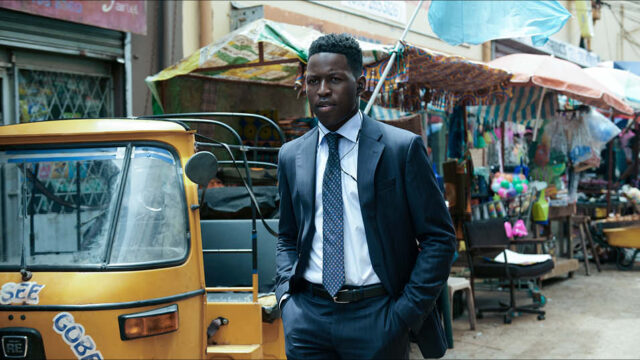
And also “taking those characters and trying to populate their world and dig into their emotional stories,” says Naomi de Pear, Sister’s joint CD of scripted and exec on The Power. “Because the book moves on incredibly quickly at the beginning. Whereas, to fall in love with characters, you need to invest in them.”
With the bible prepared, the show went out to the market. “There were several people after it,” says Featherstone. “It was pre ‘Me Too’ but the themes of inequality, not just gender, but in all power structures were pretty evident in our world anyway. So, the buyers felt that this was dealing with a subject that their audiences would love, but in a way that was entertaining and inclusive and exciting and fun. It wasn’t homework.” It’s also a big show to produce. “It’s expensive, it has scale and a vision so we had to find a partner who could match that.”
And, says de Pear “you don’t often get stories like this, with this breadth of characters, but also predominantly female characters playing such complex roles,” The show has a gangster story, with a messiah story, with a journalistic story and a story about a dictator’s wife. “They all bounced off each other,” says de Pear. “And there are not many premises you could find that would bring all of those people into one story.”
Production was first slated to start in Georgia in late 2019, but when the state brought in new controversial abortion laws, it was dropped as a location. Filming then began at the start of 2020 in Durban South Africa, and then the pandemic reared its head. “We got nearly four weeks into the shoot,” says producer Tim Bricknell. “There were two weeks in South Africa, then we came back to London and, two days before we were due to fly off to Vancouver, we were shut down in London.”
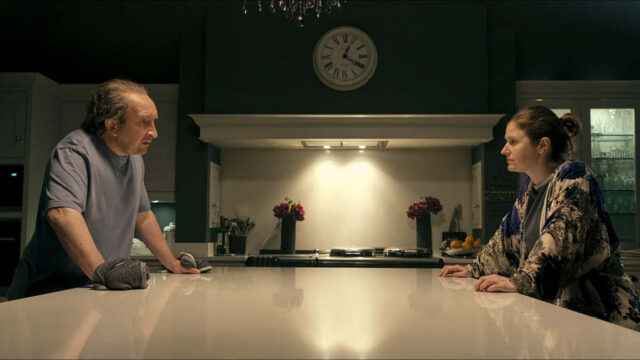
“The timing for us could not have been worse in terms of us landing in three continents,” says Featherstone.
At first, “like everybody else we were trying to work out what the pandemic was going to do,” says de Pear. “We were supposed to be shooting in three continents. We were worried about our colleagues in South Africa and Vancouver. We were trying to work out where we should go and when things might ease up. There were a lot of logistics, a lot of charts.”
“One of the biggest things we had to do was reduce the amount of international travel,” says Bricknell. South Africa wasn’t feasible until the end of 2020 and Canada effectively shut down to international travel. “So we decided that we would not film in Canada after all” with the North American strand of the story filmed between London and South Africa.
“We basically ended up shooting most of North America in London, which, I don’t need to tell you, doesn’t look that much like North America,” says Featherstone.
No small ask “especially at a time when no one really wanted a film crew running around their houses and offices. It was very tricky to negotiate locations in that time,” says Bricknell.
“We scouted as much as we could, without being allowed to travel very much or even go into buildings,” says Bricknell. Canary Wharf took on the role of downtown Seattle, “it actually worked pretty well,” says Bricknell “but finding the domestic environment was really difficult. We ended up in in a place in Gloucestershire, a new build place around a lake which did kind of look like the Pacific Northwest.” So far, so good. “But due to everything delaying and delaying we ended up filming there in February 2021. We’d got through every single problem and, on the first day of shooting, it was so cold we couldn’t drive out of the unit base to the set due to snow and ice.”
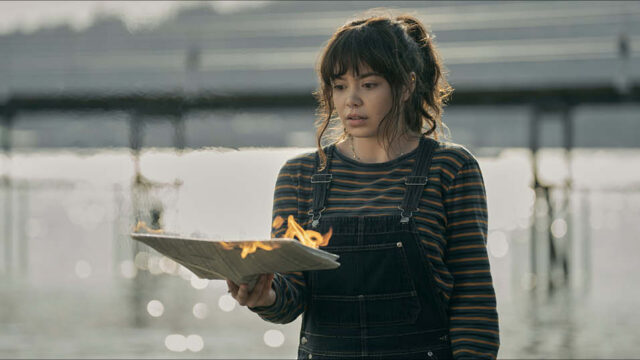
As the show went into the edit, it was felt that the North American strand of the story wasn’t quite up to scratch in terms of the locations used. By that time, Vancouver was open for shooting again and the offer came from Amazon to reshoot many scenes. Raelle Tucker came on board as showrunner but the original Margot, Leslie Mann, was no longer available, neither was Tim Robbins, who originally played Governor Daniel Dandon. The pair were replaced with Toni Collette and Josh Charles respectively.
“We went back and reshot a lot of what had been shot in London, to make it exist as a real North American city,” says Featherstone. “We just had an opportunity to make the production values better” and gaps were filled “that we just simply weren’t ever able to film” due to restrictions.
A complicated picture but, says de Pear, “in a way our scale was partly our saving grace because, in having different strands, if something goes wrong in one you can shoot another one for a bit. That was weirdly quite handy.”
“We only lost maybe three days over the whole period where we really ran out of things to film,” says Bricknell. “We didn’t really have some of the horrors you heard about from other productions of just literally having nothing to film and not being able to film.”
And that’s because “it is an industry of problem solvers,” says de Pear. “You get problems on every shoot so it was like a massive version of that.”
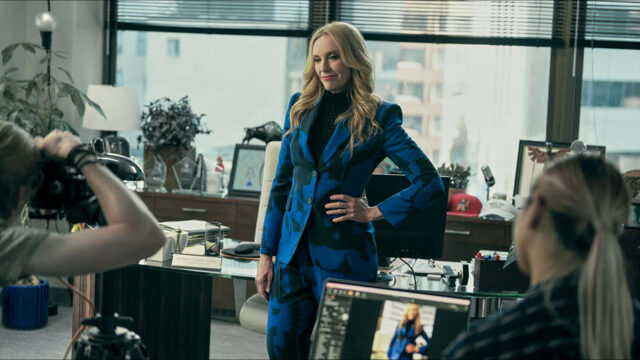
DETAILS
Broadcaster Prime Video
Production co Sister
Writers Naomi Alderman, Raelle Tucker, Claire Wilson, Sarah Quintrell, Brennan Peters, Stacey Osei-Kaffour, Sue Chung.
Directors Logan Kibens, Ugla Hauksdóttir, Shannon Murphy, Lisa Gunning, Neasa Hardiman
Execs Jane Featherstone, Naomi de Pear, Raelle Tucker, Claire Wilson, Naomi Alderman
Co-Exec Producers Tim Bricknell, Sarah Quintrell
Co-Producer Brennan Peters, Shawn Williamson
Consulting Producers Sue Chung, Ugla Hauksdóttir (1+7), Logan Kibens (2 + 4 + 7)
Showrunner Raelle Tucker
Cinematographers Colin Watkinson, Oliver Downey, Carlos Catalan, Giulio Biccari, Ruairi O’Brien,
Production Designer Sonja Klaus, Jeremy Stanbridge (Canada)
Vfx Union, Lenscare FX
Post production Warner Bros De Lane Lea (Picture), Boom (Sound)
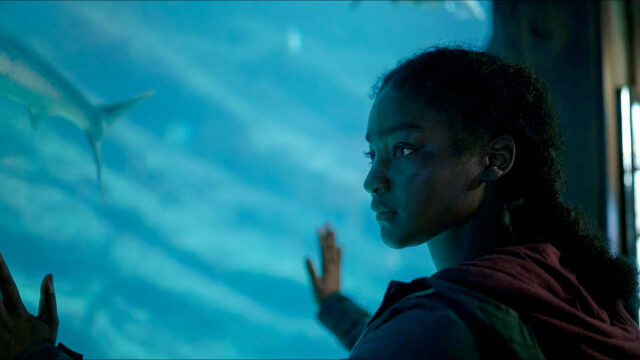
Jon Creamer
Share this story

















